Volume 26
Black Hole or MECO: Dark Matter Planets in Proto-Galaxies
Editors: Editor-in-Chief Rudolph E. Schild, Senior Editor Carl H. Gibson, and Guest Editor Stanley Robertson
Introduction by Rudy Schild
FURTHER INTRODUCTION TO VOL. 26
by Editor-in-Chief Rudolph E. Schild
New observations of submillimeter radio telescopes support the hypothesis that the central object of all galaxies is not a simple "Hawking" black hole without radiation, but a MECO, where dense clumps of dark matter planets are merging by collisional fluid mechanics, turbulence, electromagnetic forces and gravity to produce complex patterns of radiation. The clumps bring mass and angular momentum to power the plasma jet. "Hawking" black holes (aka "Schwarzschild" black holes) have (mythical) event horizons that prevent radiation from escaping the central singularity. For this reason, black holes are said to have no hair. Observations of the Milky Way central object with modern telescopes contradict this black hole characteristic in favor of the magnetosphere eternally collapsing object (MECO) description, where a complex pattern of polarized radiation reveals induced mergers of dark matter planets in the Milky Way central proto-galaxy. New analysis suggests the first MECOs were big bang objects powered by spinning pairs of magnetic monopoles and turbulent proton-antiproton plasma jets that produced inflation, mass, spin, and structure. Proto-galaxies were fragmented in the plasma epoch of the universe at 10^12 seconds (30 kyr) after the big bang, and retain the large baryonic density 10^-17 kg m^-3 existing at that time, the size of 10^20 m, as well as some of the spin of the original big bang turbulent combustion. Proto-galaxies served as collisional fluid dynamics particles during the early plasma epoch, and explain the linear chains of galaxies along fossil turbulent vortex lines detected by ultra-deep-field Hubble Space Telescope images. Dark matter clumps of a trillion earth-mass dark matter planets (DMPs) are termed proto-globular-star-clusters (PGCs). PGCs are observed to have precisely the same mass and size in all galaxies. The mass of a PGC is 10^36 kg and the size is 3x10^17 m, reflecting the Jeans mass at 10^13 seconds when the plasma of the cooling universe became gas. All stars and larger planets form by mergers of the planets within the PGCs. Star formation by merging planets at 10^13 s falsifies the standard LCDMHC cosmology, which predicts the first stars and planets arise from gas and dust at times t > 10^16 s. Life begins at 10^14 s when water can condense on the planets, but is impossible (p < 10^-6500) by LCDMHC cosmology. DNA life is inevitable with the 10^80 dark matter planets required by hydro-gravitational-dynamics (HGD) cosmology, Gibson (1996) and Schild (1996). Extra-terrestrial life is now an observational fact, as observed by Professor N. C. Wickramasinghe (Senior Journal of Cosmology Editor), and as predicted by the Hoyle-Wickramasinghe cometary panspermia hypothesis, which is now also an observational fact. The following figure JC2016.26.0.1 from Schild and Leiter 2010 shows schematically how a billion solar mass "black hole" MECO can induce jets of radiation and turbulent plasma from planet mergers and stars, powered by gravitational collapse of stratified turbulent PGC fluid from its proto-galaxy. From HGD cosmology, the proto-glalaxy has been feeding its core ever since collisional PGCs formed at 10^13 s, CHG.
Figure JC2016.26.0.1 Schematic illustration of a "radio loud low hard state" billion solar mass MECO object formed by collional fluid mechanics. Schild and Leiter (2010) show the central object SgA* of the Milky Way is a MECO and not a black hole, and is certainly not a star. Mysteries result when collisional dark matter planets in clumps of a trillion (PGCs) that dominate the mass and dynamics of all galaxies, Schild (1996) and Gibson (1996) HGD cosmology, are ignored. This collisional (NOT collisionless!) interpretation is supported by observations of powerful flairs in xrays from the Sagittarius A "star" marking the location of the Milky Way central object using the Chandra xray telescope. It is easy to explain such events from HGD cosmology, where the central MECO must eat its baryonic matter in massive clumps formed from merging dark matter planets, not continuously as the soup of gas and dust suggested by LCDMHC cosmology. Chandra telescope shows a sudden flare happens nearly every day, with occasional flares with brightness increased by 2-3 orders of magnitude, confirming the variable chunky nature of the "black hole" (MECO) food. What are these chunks? From the MECO size 2x10^13 m shown in the figure, the HGD candidate "food" objects are stars, planets and planet cores. These objects are entirely baryonic. When the rate of eating was maximum, the radiated plasma jet power was maximum, and the active galactive nucleus was a quasar, p 13548.
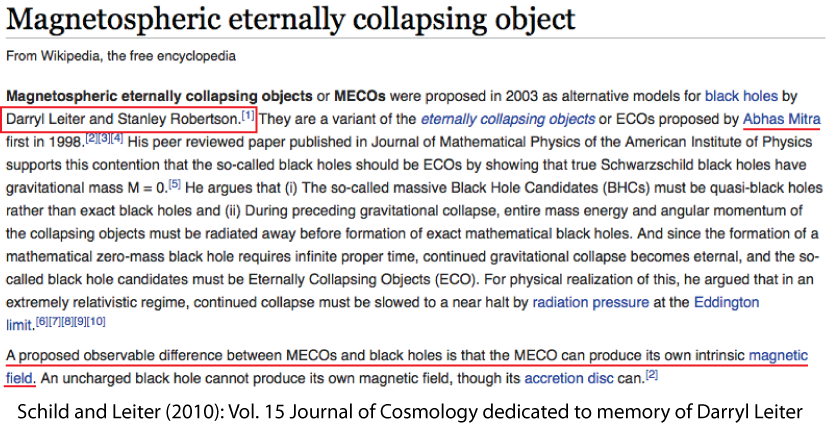
Figure JC2016.26.0.2 Wikipedia article contrasting MECOs with black holes. Abhas Mitra (1998) shows SgA* cannot be a black hole because it has mass and a magnetic field. Darryl Leiter and Guest Editor Stanley Robertson (2003) also show SGA* cannot be a black hole. It seems likely from the Schild observations of Q0957+561 that black holes are mathematical myths. "Black holes" are MECOs, and MUST be described by collisional fluid mehanics (HGD cosmology), p 13849.
Authors are cordially invited to submit all articles relevant to cosmology for this Volume 26. Give proper credit to previous work, particularly in the Journal of Bacteriology which has complained about JC2016.0.3.

Figure JC2016.26.0.3. Artwork copied without attribution, Volume 5, a Journal of Bacteriology Copyright violation overlooked by a previous J of C Editor-in-Chief. To be fair, little credit is given in Bacteriology journals to central galaxy MECOs that help mix and spread bacteria and infected dark matter planets from planetary to cosmic scales (ie: 10^14 m to >10^26 m).
CONTENTS
1. "Why MECOs are important to bacteriologists". Commentary on Volume 5 paper by Carl H. Gibson, pp 13850-13861.
2. "MECO Baby Pictures". Commentary on van Dokkum et al. (2016) observations of DRAGONFLY 44 galaxy by Carl H. Gibson, pp 13862-13868.
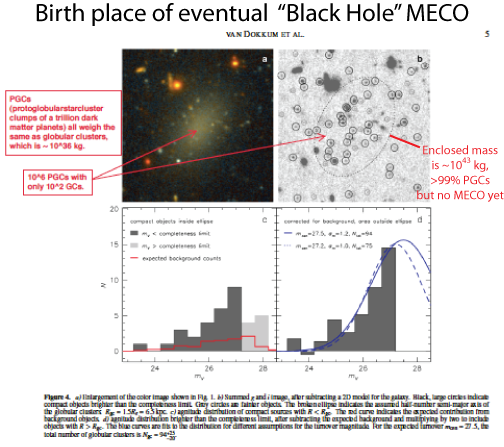
Figure JC2016.2.1 Shows an extremely dim galaxy (UDG ultra-diffuse-galaxy) in the COMA cluster at 3x10^24 m, DRAGONFLY 44, with only 100 GCs globular clusters of its million PGC protoglobularstarclusters visible. The estimated mass is ~ 10^43 kg, as expected from HGD. The figure shows baby pictures of the forming central "black hole" MECO, which requires more stars and a stratified turbulence accretion disk to power its plasma jet. HGD collisional fluid mechanics cosmology rejects the black hole concept. The observations are left as a mystery by van Dokkum et al 2016, but are easily explained by HGD, p 13869.
3. The mass of the proton, by Robert Temple, pp 13995-14090.
See some books by Professor Robert Temple.
3.1 How does the mass of a proton arise in HGD cosmology? Commentary by Carl H. Gibson on Temple, JofC 2016, Vol. 26, No. 3.1, pp 13993-13994.
This paper has been moved to the Catastrophic Equatorial Icing-dedicated Volume 28
4. Bianchi type I dust filled universe with variable bulk viscosity and vacuum energy density in C-field cosmology, by Raj Bali and Seema Saraf. pp 13956-13971.
5. A virtual universe which looks like the Universe, but without dark matter, G.Pascoli, pp 13972-13992.
6. Could Time be Logarithmic?, William K. George (Imperial College of London). Talk at APSDFD meeting 2016 Portland OR, pp 14100-14117. Paper submitted, pp14118-14132. This talk (6a), and paper (6b), are brilliantly presented and written, and are strongly recommended to all students of nonlinear processes. From HGD cosmology, logarthmic time should not be taken too literally, considering the extreme complexity of relevant physical processes during big bang, inflation, plasma and gas expansion epochs, which must somehow be reversed in the postulated HGD big crunch epoch returning to another singularity at Planck conditions.

7. SgrA* as a MECO, Rudolph E. Schild (Harvard Smithsonian center for astrophysics), pp 14118-14136.
8. Gibson (2017) Commentary on Kroupa (2016) preprint (arXiv:1610.03854); "THE OBSERVED SPATIAL DISTRIBUTION OF MATTER ON
SCALES RANGING FROM 100 KPC TO 1GPC IS INCONSISTENT WITH THE STANDARD DARK-MATTER- BASED COSMOLOGICAL MODELS". Kroupa (2016) shows clearly that all observsations falsify LCDMHC cosmology, as shown by Kroupa (2012). Gibson (2015) Commentary on " The impossibly early galaxy problem" by Steinhardt et al. (2015). However both of these important Kroupa papers neglect to point out that the fatal flaw of LCDMHC iis the false assumption of collisionless fluid mechanics, repeatedly rejected by HGD cosmology, pp 14137-14151.
9. The Port Sanilac Ice Meteorite, The first Recognized Ice Meteorite with Aquatic and Ice Biology, Duane P. Snyder. pp 14152-14176.
Figure JC2017.26.9.1 Shows stratified layers of the Port Sanilac Ice Meteorite (2016) a, with microscopic images of biological life. The meteorite seems to be of extraterrestrial origin, as concluded by Snyder. Sri Lanka (2013) red rain b images are shown for comparison. As shown by HGD cosmology, all stars form by mergers of dark matter planets, termed rogue planets by Schild and primordial fog particles by Gibson, within PGC (ProtoGlobular-star-Cluster) clumps of a trillion. These H-He planets are now frozen solid, but contain lots of thick water-ice layers that will be broken up as the planets merge to form larger planets and eventually stars. Water is formed as oxides from supernovae are reduced by the hydrogen of the planets. Because ~ 10^80 hot merging planets were produced at 0.3 Myr by the big bang, RNA-DNA life formed as a biproduct ~ 2 Myr after the big bang when water could first condense, and was spread by Hoyle-Wickramasinghe cometary panspermia as illustrated by the Snyder paper. The layering and life forms shown in the figure are easy to understand from HGD cosmology in life infested oceans, but impossible to understand if life is impossible for 300-400 Myr as assumed by LCDMHC cosmology. Counter arguments by Beech (2006) ("the problem with ice meteorites") are not convincing because they do not consider HGD cosmology and cometary panspermia. Furthermore, the tensile strength of the modeled meteorite ice appears to have been overestimated (>10^3) and the likely initial ice meteorite size underestimated (<10^2). The octopus-like creature at the lower right of a is about a mm in diameter. A security camera in Port Sanilac recorded the impact, which left a meter wide 8 inch deep crater from the original ice block, estimated to weigh > 300 kg. Sea ice chunks this large cannot be lifted to high altitude by terrestrial storms, and are most likely ice meteorites. Catastrophic equatorial icing shed by aircraft at high altitudes might be a source of ice chunks this large, but the ice would not be salty and life infested, and would not fall on Michigan. CHG p 14177.
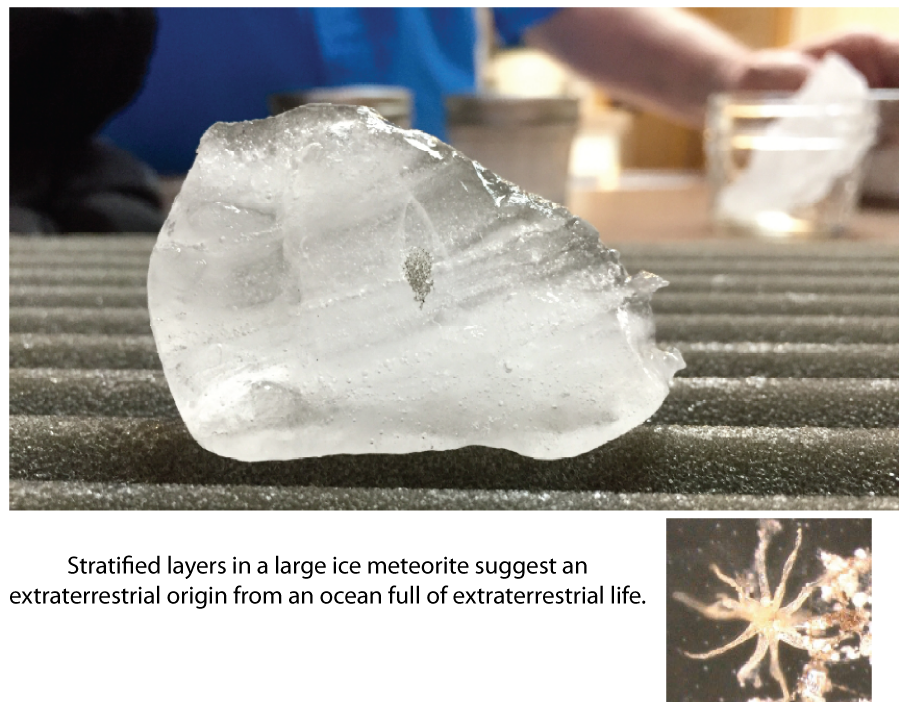
Figure JC2017.26.9.2 Shows the break up of an ice comet 73p into fragments that may become ice meteorites such as that shown above by Snyder. From Beech (2006) Fig. 1. CHG p 14178.
>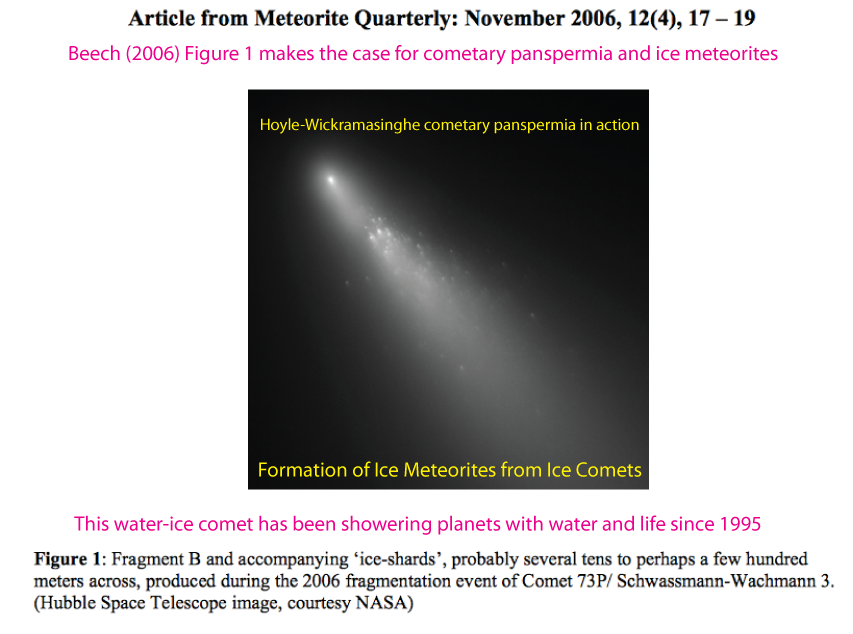
Many comets are shown breaking up near Jupiter and at their closest point of approach to the sun on the NASA Hubble Space Telescope website. These are the water-ice comets that sourced this first life infested ice meteorite ever observed. CHG p 14179.
10. Cosmological evidence that the turbulence problem is solved, Carl H. Gibson, University of California at San Diego, La Jolla CA, 92093-0411.
This paper has been moved to the Catastrophic Equatorial Icing-dedicated Volume 28
11. A NEW EXPLANATION FOR THE COSMIC MICROWAVE BACKGROUND RADIATION TEMPERATURE, Professor Robert Temple, June 21, 2017, pp 14790-14802.
12. C. H. Gibson Commentary on Lozovatsky et al. 2017, June. 25, 2017, Probability distribution of turbulent dissipation rates in the ocean, pp 14804-14848. This excellent paper fails to take into account the fact that turbulence must be defined in terms of the inertial vortex force, and that extreme intermittency near the equator causes vast quantitative and even qualitative undersampling errors.
13. A Standard Model Approach to Dark Energy and Inflation, Robert Bruce Hayes, North Carolina State University, Nuclear Engineering Department, June 26, 2017, pp 14850-14859.
14. C. H. Gibson Commentary on R. Joseph, Conclusive Evidence of Current and Past Life on Mars. This paper was rejected by the Journal of Cosmology, but is of critical importance (blockbuster!) if it can be shown to be correct, pp 14861-14906. Commentary articles on this paper will be published with high priority at the reduced rate of $50/article, payable in advance to PayPal.com cgibson@ucsd.edu, until a concensus emerges regarding its publishability. Dr. Rhawn Joseph is invited to comment and adjust the text of his draft article until such time that a decision to publish (or not) is possible.
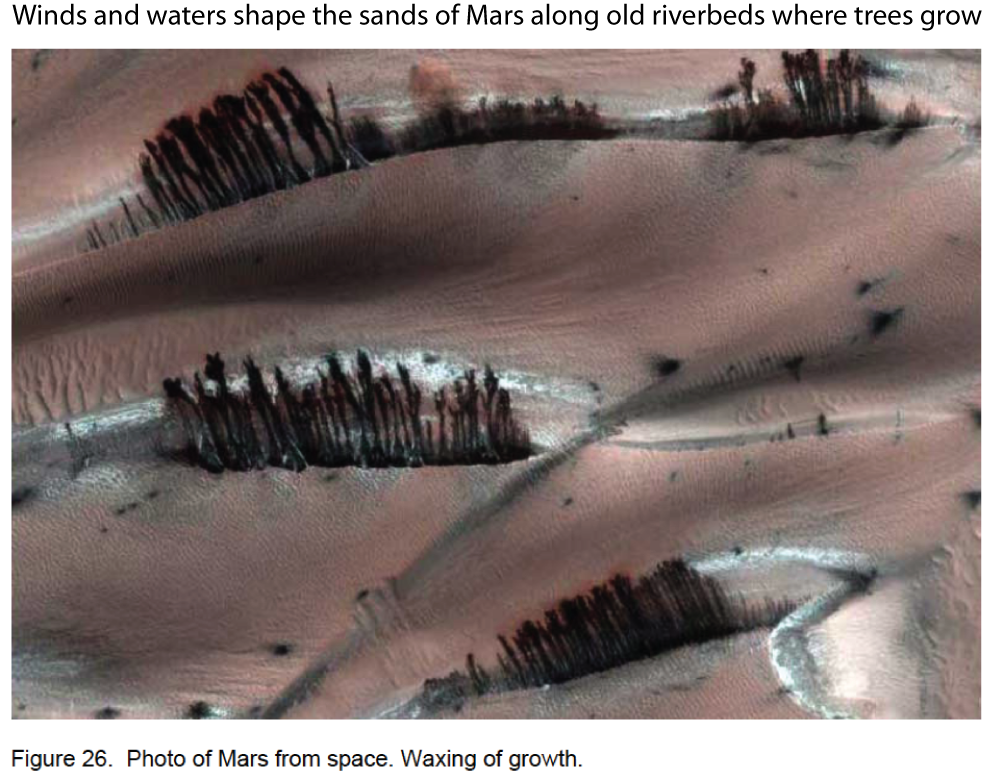
Figure JC2017.26.14.1 Shows Mars from space, but where is the data published? What is the image location? What is the time? What is the length scale? What is the season? The reader cannot be expected to answer these questions on faith, without scholarly scientific guidance. NASA uses this approach in the opposite direction; that is, against the existence of life on Mars, or anywhere but Earth, now or ever. According to NASA, collisional fluid mechnics does not exist. Therefore, viscosity cannot exist and turbulence cannot exist. Flow occurs by using the obsolete concepts of velocity potentials and linear perturbation stability analysis. These concepts are useful as mathematical approximations but cannot support a cosmology.
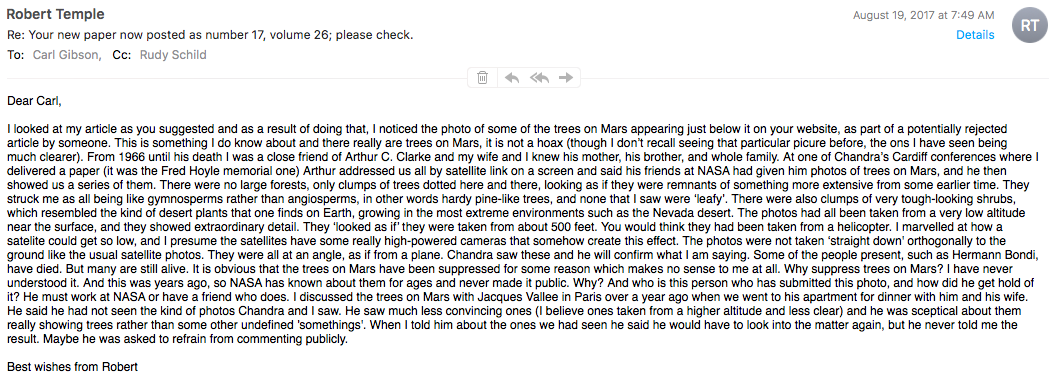
See the attached Russian reference "Microbiological Corrosion of Aluminum Alloys", Smimov et al. (2008), not mentioned by Dr. Joseph, which supports the otherwise surprising Joseph claim that corrosion from fungi caused the observed damage to the Mars Rover wheels. This data seems to remove one important aspect of the possibility that the paper is misleading or even a hoax, CHG.
15. Did Life Come From Space?, Commentary by Professor N. C. Wickramasinghe, pp 14910-14920.
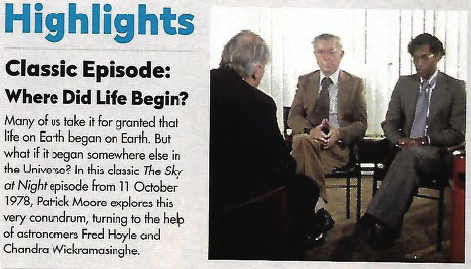
Figure JC2017.26.15.1 Shows Fred Hoyle center with Chandra Wickramasinghe right in 1978. The mechanism of the formation of life in the universe is now firmly established by the hydro-gravitational-dynamics (HGD) cosmology of Gibson (1996) and Schild (1996), which predicts the Hoyle and Wickramasinghe cometary panspermia mechanism as a natural part of star formation by gravitational condensation of earth mass dark matter planets in Jeans mass clumps of a trillion at 300,000 years (10^13 seconds) when the plasma cooled to form gas at 3000 K. Because the planets were mostly hydrogen, when the stars exploded as supernovae the oxides of carbon, silicone, nitrogen, iron and nickel all gravitationally condensed on the dark matter planets. The oxides were reduced by the hydrogen to form water atmospheres and metallic and rocky cores. Life formed in the water oceans of the planets between two million and 6 million years after the big bang as temperatures fell from liquid condensation at 373 K to freezing at 273. Gibson, C. H. APS DFD 2017 Abstract Denver Meeting November.
16. Commentary on Mroz et al. 2017,"No large population of unbound or wide-orbit Jupiter mass planets", by Carl H. Gibson, "Extensive new OGLE microlensing evidence supports HGD cosmology, but not the standard LCDMHC cosmology". pp 14940-14974.
The detected small population of Jupiter mass planets, only 2 Jupiters per star of the thousand needed, reflects the process of building stars in proto-globular-clusters by gravitational merging of the Jupiters to form all stars from merging ~10^24 kg dark matter planets within the ~10^36 kg Jeans mass PGC clumps formed at the plasma to gas transition at 300.000 years, not after 300 Myr according to LCDMHC. Note that ~ 2x10^12 dark matter planets merge to form a binary star in a PGC clump. Some of the dark matter planets will find orbits near the stars, with comforatable levels of star radiation so that water oceans can form and humanoid populations can evolve from cometary panspermia.
Hopefully, the humanoids will be intelligent enough to avoid contaminating their planet by extensive burning of fossil fuels, and will develop radiation collectors to power electric cars, ships and planes, as shown in the following figure.
Figure JC2017.26.16.1 Shows top 2017 terrestrial electric car. Laws have not yet evolved to make it illegal to sell gasoline without also providing electric charging facilities, so a 2 gallon tank and a small generator is necessary to extend the range of this car to the large distances presently existing between electric car charging stations in open country. The additional weight of the gas tank and charging generator reduces the mileage from 118 mpg without the tank and generator to only 111 mpg.

Presumably BMW will make available new colors besides proton blue to reflect the two slightly more massive baryons Xi cc++ containing charm quarks detected by CERN and FermiLab. This report from CERN makes no mention of the complex problems with standard particle physics models from neglect of collisional fluid mechanics, as well as with the standard cosmological model LCDMHC resolved by HGD cosmology of Gibson (1996) and Schild (1996). Thus, a profound state of ignorance of basic fluid mechanics is displayed by the thousands of authors and 71 institutions that employ them, as shown by this otherwise excellent paper, which identifies two new baryons with charm quarks rather than just neutrons and protons at their centers using state of the art computational techniques.
17. "A NEW EXPLANATION FOR THE COSMIC MICROWAVE BACKGROUND RADIATION TEMPERATURE", Professor Robert Temple, pp 14978-14990.
18. "On the Possibility of Replacing the Time in Cosmology by the Average Density of Matter", Professor Joseph E. Mullat, pp 14992-15015.
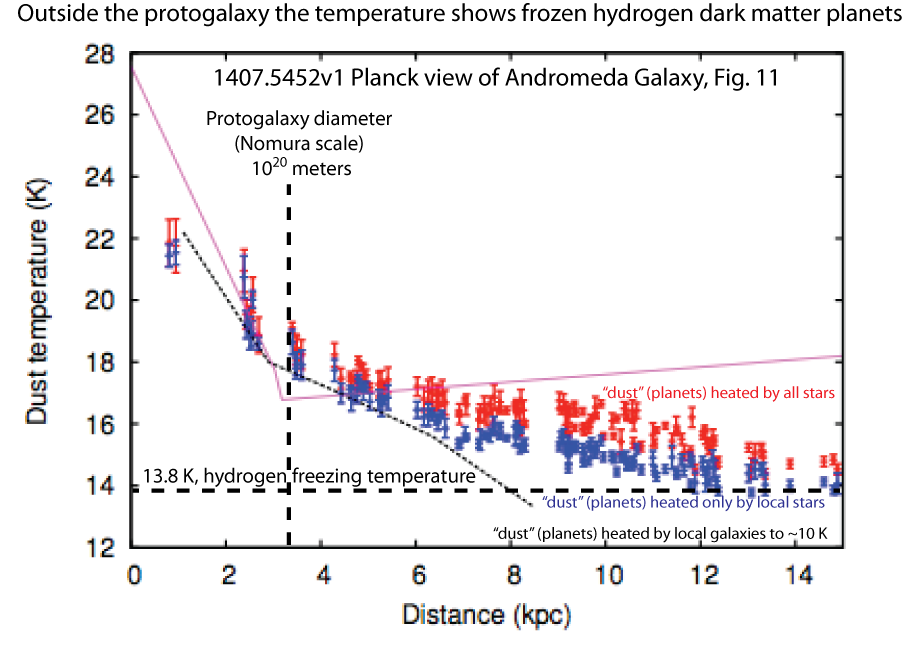
Figure JC2017.26.18.1 from 7 years of averaged Planck temperatures versus distance from the protogalaxy center in kpc of the "dust" (interpreted as dark matter planets), based on HGD cosmology of Gibson (1996) and Schild (1996). The red points show some heating by other stars of Andromeda Galaxy of dark matter planets far from the Nomura scale central core (10^20 m) of that galaxy, which approach asyptotically the freezing point of hydrogen (13.8 K) for the more distant planets, blue points. Such information has no explanation following the standard LCDMHC cosmology adopted by Professor Mullat, where the first stars and planets appear after 10^16 seconds rather than before 10^13 seconds. Fragmentation of protogalaxies occurred at ~ 10^12 seconds (~ 30 Kyr), early in the plasma epoch at the time of the second turbulence transition. The average density of matter was ~ 10^-17 kg m^-3, matching the observed density of globular star clusters.
19. Enhanced high resolution images of (4)Vesta and Ceres asteroids by the DAWN ion propelled spacecraft raise questions about accepted models of planet, star, and galaxy formation. Moran, S. and Gibson, C., Commentary on 2014 NASA Science Plan. How are these asteroids to be interpreted? Both Vesta and Ceres are loaded with water. A sample image is shown below, suggesting turbulent mixing of gases from the asteroid into the surroundings. From NASA models, the two asteroids are planets formed in place from smaller asteroids in the asteroid belt from Mars to Jupiter. From HGD cosmology, these two objects are ancient DMP (dark matter planets) formed by binary mergers in PGC proto-globular-star-cluster clumps of ~ million DMPs per star. A thousand DMPs (Schild 1996) make a Jupiter, and a thousand Jupiters made the sun and all other stars (Gibson 1996). Where did all this water come from? HGD claims H-He planets condensed in Jeans-mass clumps at the plasma to gas transition (10^13 s) before the first star was formed anywhere, all within proto-galaxies fragmented at 10^12 s. The water, and life, formed when stardust from supernovae of the first stars fell on these planets and were reduced by the hydrogen to a perfect soup of organic compounds competing for the carbon-nitrogen-oxygen of the first stars, repeatedly mixed by DMP binary mergers at a vastly earlier time and vastly distant place not considered by the NASA Science Plan.
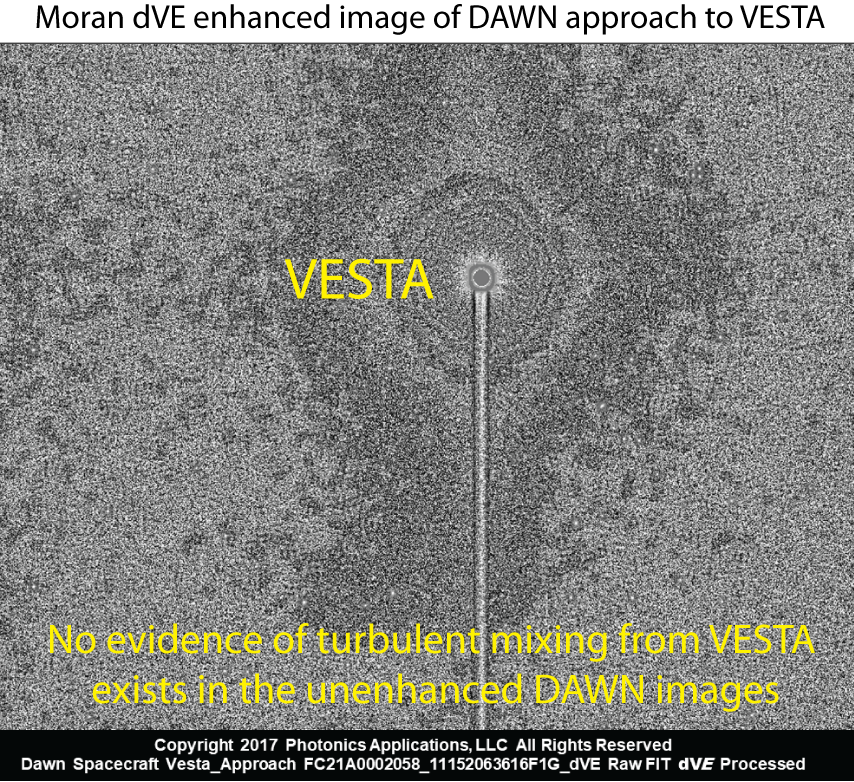
Further evidence of NASA putting a thumb on the scientific scales to suppress evidence of extraterrestrial life is implied by the mysterious images of Martian Trees shown in Figure JC2017.26.14.1, Vol. 26, Number 14 above. Evidence of water on Vesta and Ceres from DAWN bolsters HGD cosmology. LCDMHC cosmology cannot explain the enhanced DAWN observations, and leads to false conclusions in the interpretation of the excellent data produced but misinterpreted. CHG commented version of DAWN mission director C. T. Russell (2004) discussion of planetary science.
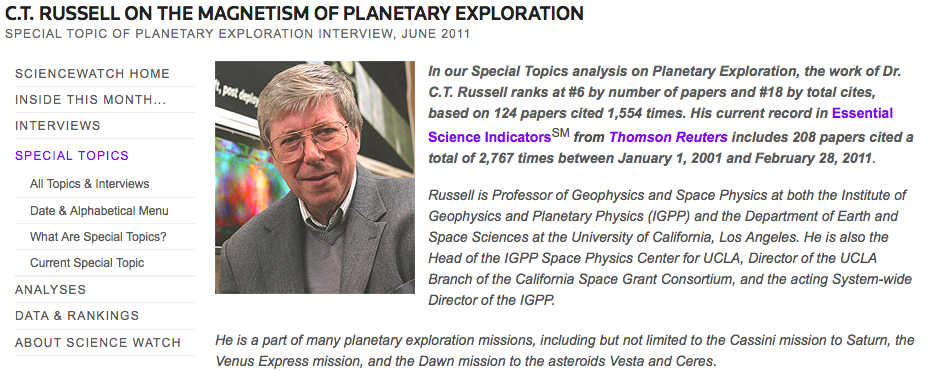
Steve Moran dVE images that enhance the excellent DAWN spacecraft observations of asteroids Vesta and Ceres may provide the observational basis for a revolutionary change in the interpretation of modern astrophysical observations. Presently faulty standard models are employed by astronomers, cosmologists and astrophysicists. The Moran proprietary algoriths are employed in a draft collection of ten images, which is the basis of a Journal of cosmology article in progress by Moran, Schild, Keeler and Gibson. The first figure shows the distortion of the VESTA atmosphere of water vapor by the solar wind. According to standard models, no turbulence or VESTA atmosphere exists.
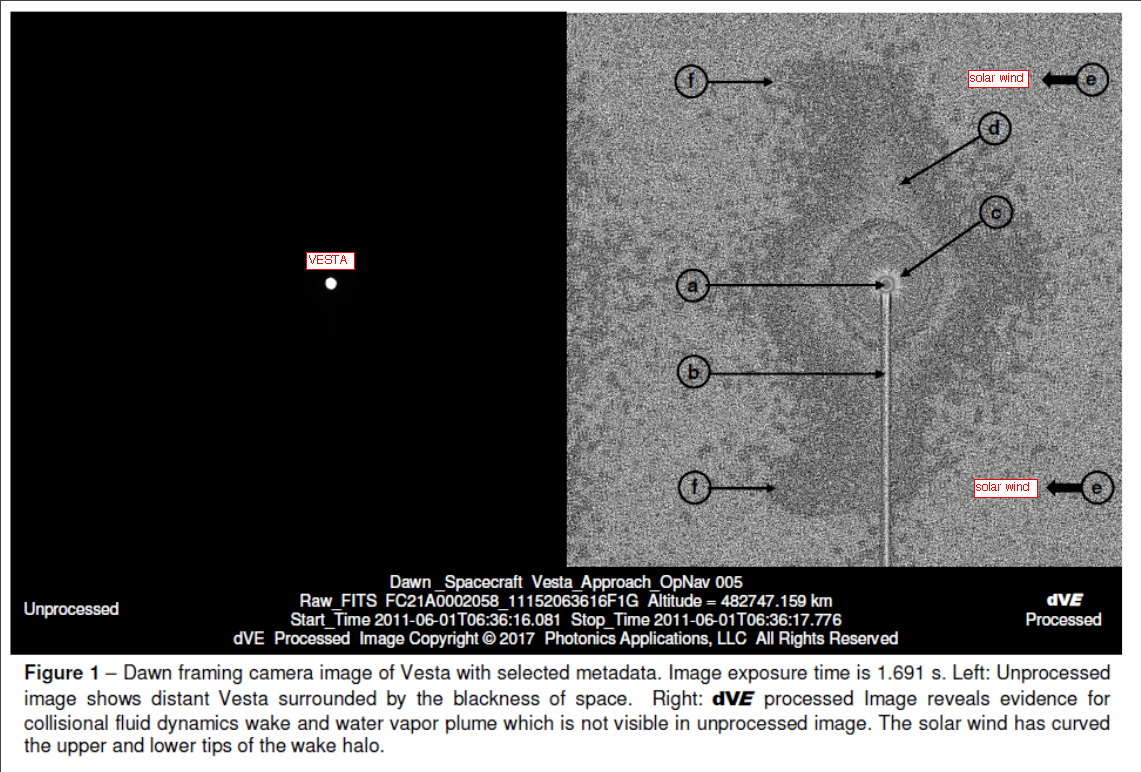
20. Gibson, C. H. Commentary on "Rocketman" Memoir of Dr. Suresh Kulkarni, Edited by his wife Diane Kulkarni. Suresh is the son
of B. S. Kulkarni, chairman of the Chemical Technology Department of Osmania University, Hyderabad AP, India, where C. H. Gibson served as a Peace Corps Volunteer at Osmania 1962-1964. Suresh developed
highly reliable methods based on his polished scientific and engineering skills that determined whether or not US man-rated rockets could be safely launched at their final stages, and personally
controlled all final go or no-go decisions on 55 successful rocket launches during his tenure working for the solid fuel rocket manufacturer. Suresh originated and developed the concept of the air-bag,
which has revolutionized world-wide automobile safety using the split second timings required to successfully control solid rockets in flight. pp 15025 - 15109

Professor Gibson urges the reader to read Suresh's 2019 Presentation in Hyderabad regarding the lessons learned from spacecraft tragedies.
21. Capt. Joseph H. (Cass) Forrington, General Relativity: Effects
in Time as Causation,
This paper is a major expansion of the original version first published as #21 in Vol. 26, on 29 July 2019. It now contains the time dilation formulas, where To = the time dilation factor, for
Planetary/Moon, $$ V = {c \sqrt{1-To}}.$$ and Galactic rotation, $$ V = {c \sqrt{1-To} \over \sqrt{3}}.$$ velocities, and the Vis-Viva formula, which means the paper provides the time dilation formulas
for all gravitationally induced velocities in the universe. Other formulas are for the force in time in Newtons, the mass inside a stellar circle, the Hamiltonian, and more, showing the direct
relationship between time dilation and velocity, with no need of the Gravitational constant, G.
The galactic and planetary orbital velocities are explained mathematically through a proper application of time dilation within the continuum,
rather than Newtonian physics in space, demonstrating that these velocities are merely compensation for the slower rates of time in masses in a continuum evolving forward overall at c.
The James Webb space telescope discovery of galaxies like GLASSz-13, z = 13.0, and other galaxies in the z= 13.2+ range, prove the validity of this model's view of the cosmological horizon.
LIGO'S Sept. 14, 2015 detection of a "gravity wave" is a proof that spacetime is a continuum, and a proof of the nature of the evolving continuum is IBEX failing to find a shock wave at the edge of
the heliopause as expected, because the heliosphere is not "moving through space", but is evolving through the continuum. This is reaffirmed by the "dead zone" discovered by Voyager 1
The origin of spacetime is explained. This is a new continuum-based model based on time dilation that eliminates LamdaCDM; Dark Energy and CDM.
A second paper by Capt. Forrington, Time Dilation Cosmology, was published
in the Journal of Modern Physics on 29 May 2023. As (1-To) = the difference in the rate of time, dRt, between the far distant observer outside all gravitational fields and the coordinate point, that
paper further reduces the formulas to terms of the dRt and contains solutions using those formulas and other additional formulas. New concepts are also introduced regarding spiral galaxy formation and other
topics.

Capt. Forrington is a Cum Laude graduate of the United States Merchant Marine Academy at Kings Point, New York, 1972. He has had a lifelong interest in quantum physics, relativity and cosmology.
One particular statement he read decades ago about General Relativity describing the "curvature of events in the forward direction of time", often came back to occupy his thoughts and, in 2013,
he had an inspiration regarding gravity as an evolution of events in the forward direction of time within the quantum continuum that sent him back to school to refresh his calculus, then study quantum
mechanics and tensor calculus
so he could develop his concept further from there. For the concept to work, the Hubble shift had to be able to be explained as being due to time dilation and it took three years of attempts to finally
arrive at the final, definitive, derivation.
pp 15110 - 15145.
22. Enrique Alvarez Vita, Academia Peruana de Filosofia y Ciencia, ANTIMATTER BLACK HOLES,
We propose an alternative gravity model to the theory of general relativity, in which the spacetime curvature would be modified by the interaction of matter and antimatter virtual particles,
both interacting with each other and with matter through fractal sublevels of the quantum vacuum, creating a sequence of gravitational shielding and anti-shielding effects. The equations of planetary
motion based on the Schwarzschild metric and its variables would be modified, as would current theories about black holes which would be made of antimatter.
pp 15153- 15184.
23. Ermanno F. Borra DÈpartement de Physique, GÈnie Physique et Optique, UniversitÈ Laval, QuÈbec, Qc, Canada G1K 7P4,
A Novel Technique to Study the Structure of the Universe,
The universe can be modeled as a gigantic reservoir where only waves that have an integer number of modes are allowed; therefore the spectrum of the cosmic background radiation has missing frequencies.
The spacing between frequencies is hopelessly small to be detectable with conventional techniques. However, beats among the frequencies give rise to intensity fluctuations that have much lower frequencies,
allowing observations that can measure the spectral structure introduced by the cosmological reservoir. The spectral structure gives information on the large scale structure of the universe. For example,
it can give the Hubble constant.
pp 15206 - 15220.
24. Yvan Leblanc,
New Tolman-Oppenheimer-Volkoff Formula in Einstein Real Gravity,
Einstein Real Gravity (RG) is Einstein General Relativity (GR) with an exponential parametrization of the metric tensor. The tensor poten- tial field in the argument of the exponential is interpreted as
the physical spin-2 gravitational field. This allows the linear separation of the space- time curving real gravitational tensor force from the other non-tensor non spacetime curving inertial forces in the
Christoffel symbols. The use of cartesian coordinates filters out these non-tensor forces and leads to a de- scription of GR as the pure RG affine tensor theory. A modified expression for the hydrostatic
Tolman-Oppenheimer-Volkoff formula for stellar equi- librium is derived and applied to the ultra-relativistic spherical perfect fluid case. An exact analytical solution is found.
pp 15250 - 15268.
25. Louise Riofrio,
An Exceptionally Simple Experiment Testing Quantum Theory,
A simple equation GM = tc3 explains many puzzles about the Universe, and may provide a link between Relativity and Quantum Mechanics. The quantities h and c could provide a first link.
Conversion to the Planck units of time, length, and mass indicates that these units are fundamental. A simple experiment tests whether the Planck mass is part of a quantized gravity. This experiment
may also be conducted in the microgravity environment of Space. Applications extend from the large Universe to the microscopic world, including the scale of living cells.

LOUISE RIOFRIO earned her degree in Physics and Astronomy at San Francisco State University in California. She worked as Scientist at NASA Johnson Space Center in Houston, studying the Moon. While performing experiments with priceless Apollo lunar samples, she used the Moon to test theories of cosmology. More recently she has contributed to a Lunar Observatory project scheduled for the first lunar landers. She works on the Island of Hawaii.
pp 15309 - 15316.
26. Yvan Leblanc,
The Universal Euler Equation in Einstein Real Gravity,
Making use of the Bianchi identity together with the Yilmaz exponential
parametrization of General Relativity with the so-called tensor
potentials describing the physical gravitational field, a universal
hydrodynamical Euler equation is derived for a general relativistic
fluid. This novel relationship remains valid in the presence of
gravitational waves, as it takes into account the full tensorial
character of the gravitational field. As a special case, we recover the
general hydrodynamical evolution formula for the single component
newtonian gravitational field of a relativistic fluid. An important
application is the re-analysis of perturbative Jeans' theory of
gravitational instability and the study of sound waves in the presence
of a gravitational field and their interaction with gravitational waves.
pp 15346 - 15358.
27. Bradford C. Blake,
Relativistic Beaming of Gravity and the Missing Mass Problem,
This paper proposes the idea that gravity emanating from a source moving at relativistic speeds should be beamed in the same manner as light. Further, that an array of compact objects in the
galaxy resulting from supernovae, primarily stellar mass black holes undergoing relativistic rotation, could thereby concentrate their gravitational force into the stellar plane of the galactic disk.
This would make possible speeds in excess of Keplerian limits for stars and gas clouds, especially in the outer portions of the galaxy. I model the galactic disk as a cylinder, and use Gauss's law to
derive a 1/r formula for the resulting gravitational force, which I call "directed gravity." This 1/r force could explain the flat rotation curve of the galaxy. Further, the theory of directed
gravity is shown to be compatible with the studies of the Bullet cluster, making it superior to the low-acceleration form of MOND, and a viable alternative to Dark matter halos.
pp 15390 - 15409.
28. Yvan Leblanc,
Physical Justification for the Einstein Real Gravity formulation of General Relativity,
For diagonal metrics, the Einstein Real Gravity (RG) formulation of
General Relativity (GR) has been developed by making use of an
exponential parametrization of the metric tensor in terms of physical
tensor potentials. But the metric is not an experimentally observable
quantity and so this parametrization has yet to be physically justified,
although, starting with Einstein's 1907 early treatment, there exist
strong arguments in its favor. To address the issue, we RE-DEFINE the
physical tensor potentials in terms of first order derivatives of the
metric tensor, which are linearly related to the observable
gravitational force field and the Christoffel symbols. Identifying the
00-component of the re-defined tensor potentials with Newton's
gravitational potential, we show EXACT OBEDIANCE with (1) Newton's
second law of motion from the geodesic equation for a point particle as
well as with the (2) relativistic hydrostatic equilibrium relation for a
perfect fluid from the Freud-Euler equation. These provide convincing
physical justification for the Real Gravity formulation of General
Relativity. Real gravitational and inertial forces are still linearly
separated in the Christoffel symbols and the new definition coincides
with the exponential parametrization for diagonal metrics. Non-diagonal
stationary spacetimes or spacetimes allowing gravitational waves can now
be treated consistently. Event horizons cannot develop in this theory.
pp 15420 - 15438.
29. Bradford C. Blake,
Black Holes Leak at the Poles: Solving the Mass Injection Problem of Astrophysical Jets by using Directed Gravity,
This paper proposes the idea that gravity emanating from a source moving at relativistic speeds should be beamed in the same manner as light. Further, that an array of compact objects in the
galaxy resulting from supernovae, primarily stellar mass black holes undergoing relativistic rotation, could thereby concentrate their gravitational force into the stellar plane of the galactic disk.
This would make possible speeds in excess of Keplerian limits for stars and gas clouds, especially in the outer portions of the galaxy. I model the galactic disk as a cylinder, and use Gauss's law to
derive a 1/r formula for the resulting gravitational force, which I call "directed gravity." This 1/r force could explain the flat rotation curve of the galaxy. Further, the theory of directed
gravity is shown to be compatible with the studies of the Bullet cluster, making it superior to the low-acceleration form of MOND, and a viable alternative to Dark matter halos.
pp 15460 - 15483.
30. Hoang Nguyen-Duong,
Which of the Two Competing Cosmological Models is the Most Probable: an Eternal Steady-State Model or a Big Bang Model Emerging From an "Exploding" Single Particle? ,
In 1949, as the term "Big Bang" was coined for the first time in cosmology, an enduring controversy began between the proponents of a stationary, expanding eternal universe and the proponents of a
universe that arose from a hot "primordial atom" from which space, time and all chemical elements should have arisen. The putative trigger for the Hot Big Bang theory was the physicist Gamow's belief
that his findings about nucleosynthesis should fit perfectly with the "primeval atom"-theory of the cosmologist and mathematician Lemaître. The cosmic microwave background radiation predicted at the
same time and discovered by chance in 1964 was then celebrated as a triumphant confirmation of the Big Bang hypothesis. However, many questions that are by no means ingenuous remained unanswered. Is
there such a thing as a center of the universe, where everything began? As it continues to expand, where does it expand? There must be some space at the edge of the universe into which it is expanding.
What happened before the Big Bang? How can our entire universe have arisen from an "empty vacuum"? The aim of the author of this article is in no way to deal with the ongoing work carried out by very
well specialized cosmologists, but rather to express the legitimate doubts of a scientist fairly inexperienced in cosmology, as to whether the claim of the Big Bang theory to be considered as definitive
is justified. Anyway, according to the latest findings, and since the energy of the "empty vacuum" (dark energy) identified as the cosmological constant ? can be used to describe the recently discovered
accelerated expansion of the universe, it is tempting to hypothesize that the opposing forces of gravitation and dark energy may combine, leading to an oscillating eternal universe.
pp 16000 - 16018.
31. Daniel E. Friedmann,
Resolving the Hubble Tension by Taking Gravitationally Bound Space Into Account ,
The Hubble tension arises from the difference between direct measurements of the Hubble constant and indirect measurements, given a cosmological model. Measurements have been confirmed with increasing
precision, pointing to an issue with the cosmological model. However, the simplest Lambda cold dark matter model provides a good fit for a large span of cosmological data. In this paper, we keep the
Lambda cold dark matter model but modify it to consider the possible effect of gravitationally bound space. Modeling shows that as large gravitationally bound structures - namely, galaxy clusters -
develop and gravitationally bind the space they enclose, their impact on the universe's rate of expansion resolves the Hubble tension.
pp 16030 - 16057.
32. Bradford C. Blake,
An Explanation for the Mass Gap between Neutron Stars and Black Holes, and a Proposed Unification ,
Neutron stars and black holes are surprisingly similar objects. I examine the theory behind the maximal mass of neutron stars, and find the assumption that additional gravitational collapse of neutron
stars creates black holes to be unjustified. Instead, I propose that black holes are created whenever the radius of a compact object is smaller than the object's Schwarzschild radius. My calculations
indicate that this should happen for compact objects of mass larger than about 5.3 solar masses. I propose that the apparent lack of compact objects between slightly larger than 2 solar masses and about
5 solar masses occurs because any such objects would be unstable neutron stars that would therefore shed mass.
pp 16099 - 16108.